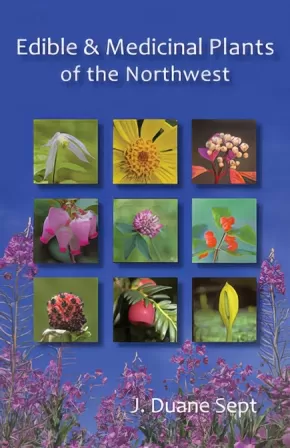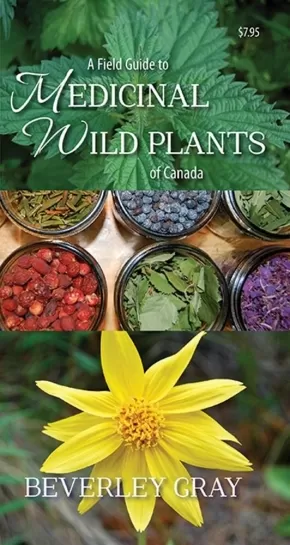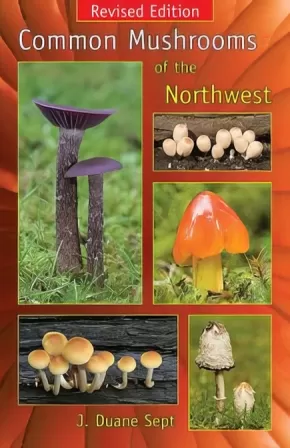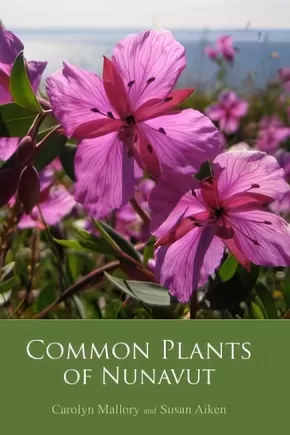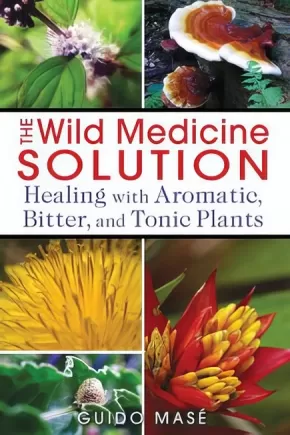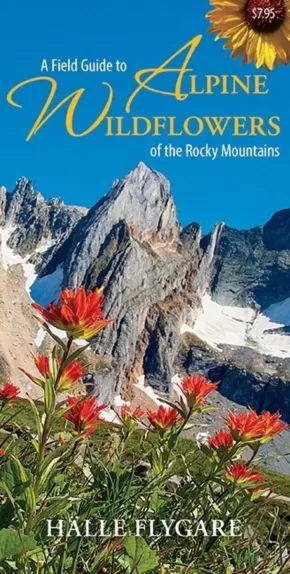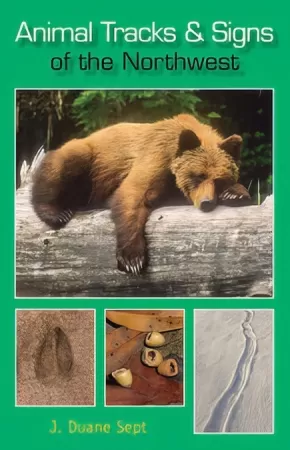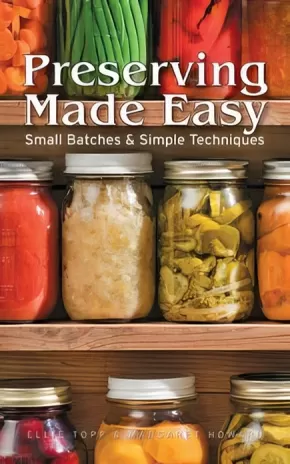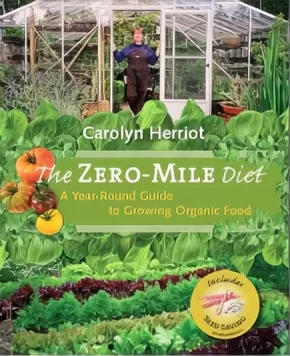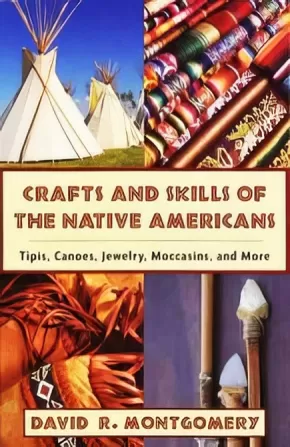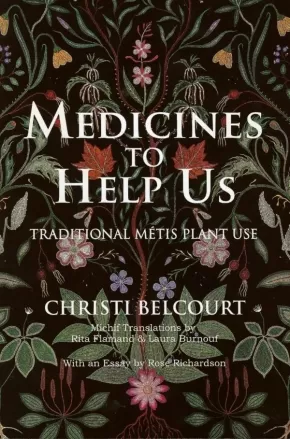
Self-Sustainability
61
-
75
of
82 Results;
Sort By
Go To
of 6
Edible & Medicinal Plants of the Northwest
$14.95
Format:
Paperback
Text Content Territories:
Indigenous;
ISBN / Barcode: 9780973981988
Synopsis:
Synopsis:
The edible and medicinal wild plants of the Northwest have a long history of traditional use, with some remarkable success stories. Hundreds or perhaps thousands of years’ experience with the nourishing and healing properties of indigenous plants have been passed down through generations of Native peoples. Today, some deadly diseases such as breast and ovarian cancers are treated with extracts from native plants. Many roots, flowers, leaves and stems can be eaten raw or cooked, and some plants can even be made into beer. A surprising number of common local plants make tasty, nutritious treats or relieve health troubles. Meet 66 of them in this amazing new book!
Chapters include information on trees, shrubs, wildflowers, aquatic plants, horsetails, ferns and poisonous plants with lists of therapeutic plant uses and a medicinal glossary.
A Field Guide to Birds of the Pacific Northwest
$7.95
Artists:
Format:
Pamphlet
ISBN / Barcode: 9781550176056
Synopsis:
Synopsis:
Do you know a tanager from a towhee? A goatsucker from a grosbeak? Here, after much demand, is a waterproof, portable 8-fold guide featuring 112 photos of the common birds found in coastal areas of Oregon, Washington, British Columbia and Alaska. Each species is labelled with common name, size, distribution range and favoured habitat. This full-colour pamphlet is useful to anyone who has an interest in taking up birdwatching, or just wants to figure out what's flitting about the birdfeeder.
Additional Information
2 pages | 37.00" x 9.00" | field guide with 112 colour photographs
A Field Guide to Medicinal Wild Plants of Canada
$8.95
Format:
Pamphlet
Reading Level: N/A
ISBN / Barcode: 9781550176032
Synopsis:
Synopsis:
Nature heals! This compact field guide introduces readers to 26 common Canadian wild plants with extraordinary healing properties. Use arnica blossoms to heal muscle inflammation, improve digestion with chickweed and soothe a toothache with yarrow root--learning to identify and use wild medicinal plants is both fascinating and useful.
Each plant profile includes a colour photograph, identification and habitat information, as well as medicinal, cosmetic and culinary uses. Skilled herbalist Beverley Gray also includes tips on how to sustainably gather and safely use beneficial wild plants.
Additional Information
2 pages | 4.50" x 8.70" | 30 photographs | Pamphlet
Common Mushrooms of the Northwest
$14.95
Format:
Paperback
ISBN / Barcode: 9780973981964
Synopsis:
Synopsis:
This easy-to-use handbook offers information about common mushrooms from Alaska and northwestern Canada to Saskatchewan in the east and south to the US states of the Pacific northwest. Using crisp, colourful images, Duane Sept illustrates more than 130 species of edible, poisonous and other interesting mushrooms. Inside you’ll find:
~ In depth descriptions for 130 species
~ Details on edible, poisonous, hallucinogenic and other fascinating fungi
~ More than 150 fascinating fungi
~ More that 150 spectacular photographs
~ Tips and techniques for freezing, canning and drying mushrooms
~ Additional information about mushroom ecology, making spore prints and more
~ New edition includes updated scientific names and new species
Common Plants of Nunavut
$19.95
Format:
Paperback
Text Content Territories:
Indigenous Canadian; Inuit;
ISBN / Barcode: 9781927095195
Synopsis:
Synopsis:
Explore the fascinating world of Nunavut’s varied plant life in this richly visual, informative book.
Through beautiful photographs and a broad range of information including traditional knowledge about plant use compiled through interviews with Inuit elders readers will learn about the appearances, adaptations, life cycles, and habitats of the diverse array of plants that live in the North.
Far beyond a barren land of ice and snow, this book will introduce readers to the beautiful variations of plant life that abound on the tundra.
Additional Information
205 pages | 9.00" x 6.50"
Modern Native Feasts
$26.95
Format:
Paperback
Text Content Territories:
Indigenous;
Reading Level: N/A
ISBN / Barcode: 9781551525075
Synopsis:
Synopsis:
Contemporary, imaginative interpretations of First Nations cuisine, including lighter, healthier, and more nutritious versions of traditional recipes.
Native American cuisine comes of age in this elegant, contemporary collection that reinterprets and updates traditional Native recipes with modern, healthy twists. Andrew George Jr. was head chef for Aboriginal foods at the 2010 Winter Olympics in Vancouver; his imaginative menus reflect the diverse new culinary landscape while being mindful of an ages-old reverence for the land and sea, reflecting the growing interest in a cuisine that is rapidly moving into the mainstream to become the "next big thing" among food trends. Andrew also works actively at making Native foods healthier and more nutritious; his recipes are lighter, less caloric, and include Asian touches, such as bison ribs with Thai spices, and a sushi roll with various cooked fish wrapped in nori. Other dishes include venison barley soup, wild berry crumble, sea asparagus salad, and buffalo tourtiere.
Full of healthy, delicious, and thoroughly North American fare, Modern Native Feasts is the first Aboriginal foods cookbook to go beyond the traditional and take a step into the twenty-first century.
Reviews
"Modern Native Feasts fuses traditional recipe preparations like brining, smoking, and curing with using fresh, local, seasonal ingredients readily available in many supermarkets. Meals reflect a diverse new culinary landscape built on an age-old reverence for the land and sea." — Gastrotraveling.com, December 2013
"The resulting recipes are unfussy yet often elegant, perfect for either a potlatch or a potluck ... George keeps his intros blessedly short, while still telling the background of each dish; the cookbook is beautifully designed, with a rustic look that's carried throughout." — The Oregonian, November 2013
"Whatever you have in mind when you conjure up the image created by the title Modern Native Feasts, you won't be imagining anything quite like this. Chef George has taken the best of his indigenous Canadian culture and traditions and fused it with his modern training, plus a generous helping of very real talent and created a cuisine that, while it may be distinctly his, could feasibly represent a beautiful -- and delicious -- future ... This is sophisticated contemporary food perfectly informed by the chef's heritage and own sensibilities." ―January Magazine
Additional Information
192 pages | 8.00" x 9.00"
The Wild Medicine Solution (4 in Stock) - ON SALE!
$20.00 $27.50
Format:
Paperback
ISBN / Barcode: 9781620550847
Synopsis:
Synopsis:
Restoring the use of wild plants in daily life for vibrant physical, mental, and spiritual health
• Explains how 3 classes of wild plants--aromatics, bitters, and tonics--are uniquely adapted to work with our physiology because we coevolved with them
• Provides simple recipes to easily integrate these plants into meals as well as formulas for teas, spirits, and tinctures
• Offers practical examples of plants in each of the 3 classes, from aromatic peppermint to bitter dandelion to tonic chocolate
As people moved into cities and suburbs and embraced modern medicine and industrialized food, they lost their connection to nature, in particular to the plants with which humanity coevolved. These plants are essential components of our physiologies--tangible reminders of cross-kingdom signaling--and key not only to vibrant physical health and prevention of illness but also to soothing and awakening the troubled spirit.
Blending traditional herbal medicine with history, mythology, clinical practice, and recent findings in physiology and biochemistry, herbalist Guido Masé explores the three classes of plants necessary for the healthy functioning of our bodies and minds--aromatics, bitters, and tonics. He explains how bitter plants ignite digestion, balance blood sugar, buffer toxicity, and improve metabolism; how tonic plants normalize the functions of our cells and nourish the immune system; and how aromatic plants relax tense organs, nerves, and muscles and stimulate sluggish systems, whether physical, mental, emotional, or spiritual. He reveals how wild plants regulate our heart variability rate and adjust the way DNA is read by our cells, controlling the self-destructive tendencies that lead to chronic inflammation or cancer.
Offering examples of ancient and modern uses of wild plants in each of the 3 classes--from aromatic peppermint to bitter dandelion to tonic chocolate--Masé provides easy recipes to integrate them into meals as seasonings and as central ingredients in soups, stocks, salads, and grain dishes as well as including formulas for teas, spirits, and tinctures. Providing a framework for safe and effective use as well as new insights to enrich the practice of advanced herbalists, he shows how healing “wild plant deficiency syndrome”--that is, adding wild plants back into our diets--is vital not only to our health but also to our spiritual development.
A Field Guide to Alpine Wildflowers of the Rocky Mountains
$7.95
Format:
Pamphlet
Reading Level: N/A
ISBN / Barcode: 9781550175530
Synopsis:
Synopsis:
With gorgeous full-colour photos arranged in an easy-to-use colour-coded chart for quick identification, this pocket-sized laminated pamphlet is perfect for taking along on walks and hikes through the Rocky Mountains, from BC and Alberta to New Mexico. Supplying English and Latin names, the distribution range of each species and average plant height and flower size, Halle Flygare shares his knowledge and pictures of flora gained through over 30 years as a photographer, park warden and guide in the Rocky Mountains.
Additional Information
2 pages | 4.50" x 9.00" | 112 Colour Photographs
A Field Guide to Trees of the Pacific Northwest
$7.95
Format:
Pamphlet
Reading Level: N/A
ISBN / Barcode: 9781550175721
Synopsis:
Synopsis:
This laminated guide features twenty-six native trees commonly found from Alaska to Oregon, providing common and Latin names accompanied by colour photographs of identifying features such as bark, leaves or needles, flowers, cones, seeds and fruit. Information on identification, range and an illustration of each tree's silhouette make it a snap to distinguish a shore pine from a western white pine or a trembling aspen from a paper birch. Also included are traditional uses and other interesting tree facts and lore. For example, did you know that yellow cedar can live up to 5,000 years? Or that the bigleaf maple flowers are edible? Next time you go for a hike, pay attention to the forest and the trees with one of these laminated guides slipped into your back pocket or backpack.
Additional Information
2 pages | 37.00" x 9.00" | color photographs and illustrations | pamphlet
Animal Tracks & Signs of the Northwest
$14.95
Format:
Paperback
ISBN / Barcode: 9780973981957
Synopsis:
Synopsis:
Welcome to the secret world of tracks, sign and the animals that made them. Signs of the who, what and where of wildlife are all around us, even when their makers are too shy to come closer. This new guide is the key to unlocking the natural world that shares our environment, by day and by night. All we have to do is take the time to observe and interpret the signs.
The book features nearly 50 species with photos of tracks, scat and other signs, as well as drawings of tracks, track patterns, distribution maps and interesting details on the appearance, habitat and behavior of each species. Information on 20 additional species is also included, to help identify other species in the area and to distinguish one animal from another. There is even a ruler on the back cover. Tracking is detective work—fun, stimulating and very inspiring for anyone who is ready to “meet” the animals that share our landscape, by studying the fascinating clues they leave behind.
Preserving Made Easy: Small Batches and Simple Techniques (1 in Stock) - ON SALE!
$7.50 $9.99
Format:
Paperback
ISBN / Barcode: 9781770850941
Synopsis:
Synopsis:
Preserving Made Easy is the perfect book for today's busy cooks who still want to prepare and enjoy the homemade goodness of fresh fruits and vegetables. These recipes were selected for their delicious taste and because they are easy to prepare.
Thoroughly tested and perfected, each recipe offers something special--a new twist on an old favorite, a new way to mix and match flavors and tips to make the whole process easier and more fun.
The authors offer delectable recipes for jams, jellies, conserves, pickles, relishes, chutneys, salsas, mustards, marinades, flavored oils and more. Everything you need to delight family and friends is here. Using this book will ensure that your family has only the best and freshest ingredients carefully prepared for their needs.
Preserving Made Easy is ideal for first-time users who will benefit from the step-by-step introductions, and for experienced cooks who are just looking for that extra twist that will make the batch memorable.
A Field Guide to Edible Mushrooms of the Pacific Northwest
$9.95
Format:
Pamphlet
ISBN / Barcode: 9781550175424
Synopsis:
Synopsis:
A Field Guide to Edible Mushrooms of the Pacific Northwest is a waterproof pocket-sized guide with full-colour photographs of mushrooms from Pacific Northwest trails and roadsides, forests and lawns. With this guide, identify over thirty common and easily-recognized edible mushrooms--and stay away from their not-so-edible look-alikes. Discover boletes, chanterelles, matsutake, shaggy mane, cauliflower, candy cap and many other tasty wild mushrooms. Easy to use and light to carry, this compact text is a must-have for all mushroom lovers who delight in searching for the next macrofungi bonanza.
Additional Information
2 pages | 37.00" x 9.00" | waterproof, pocket-sized guide with 50+ colour photographs
The Zero-Mile Diet: A Year-Round Guide to Growing Organic Food
$32.95
Format:
Paperback
ISBN / Barcode: 9781550174816
Synopsis:
Synopsis:
This definitive month-by-month guide brings gardeners into the delicious world of edible landscaping and helps take a load off the planet as we achieve greater food security. Full of illustrative colour photos and step-by-step instructions, The Zero-Mile Diet shares wisdom gleaned from 30 years of food growing and seed saving with comprehensive advice on:
• Growing organic food year-round
• The small fruit orchard and backyard berries
• Superb yet simple seasonal recipes
• Preserving your harvest
• Seed saving and plant propagation
• Dirt-cheap ways to nourish your soil
• Backyard poultry—it’s less time-consuming than you
think
• Growing vegetables in the easiest way possible
• A–z guide to growing the best vegetables and herbs
Put organic home-grown fruits and vegetables on your table throughout the year, using the time-saving, economical and sustainable methods of gardening outlined in The Zero-Mile Diet. This book is about REAL food and how eating it will change our lives for the better.
Crafts and Skills of the Native Americans: Tipis, Canoes, Jewelry, Moccasins, and More (3 in Stock) - ON SALE!
$16.00 $19.95
Format:
Paperback
Text Content Territories:
Indigenous American; Native American;
Reading Level: N/A
ISBN / Barcode: 9781602396760
Synopsis:
Synopsis:
Crafts and Skills of Native Americans is a fascinating, practical guide to the skills that have made Native Americans famous worldwide as artisans and craftsmen. Readers can replicate traditional Native American living by trying a hand at brain tanning, identifying animal tracks, or constructing a horse saddle. Readers can even make distinctive Native American beaded jewelry, a variety of moccasins, headdresses, and gourd rattles. Native American style is unique and popular, especially among young people, historians, and those with a special interest in the American West.
Additional Information
240 pages | 5.50" x 8.50"
Medicines to Help Us: Traditional Métis Plant Use
$25.00
Artists:
Text Content Territories:
Indigenous Canadian; Métis;
ISBN / Barcode: 9780920915790B
Synopsis:
Synopsis:
Based on Métis artist Christi Belcourt’s painting “Medicines to Help Us,” this innovative and vibrant resource honours the centuries-old healing traditions of Métis women. With contributions from Métis Elders Rose Richardson and Olive Whitford, as well as key Michif phrases and terminology, Medicines to Help Us is the most accessible resource relating to Métis healing traditions produced to date.
Educator Information
This resource guide does not include the study prints referred to on the back cover and within the book.
Michif Translators: Laura Burnoff and Rita Flamand
Elder Validation: Rose Richardson
Format: Book Only - English, with plant names in Michif, Nehiyawewin (Cree), and Anishinaabemowin (Ojibway)
Sort By
Go To
of 6

